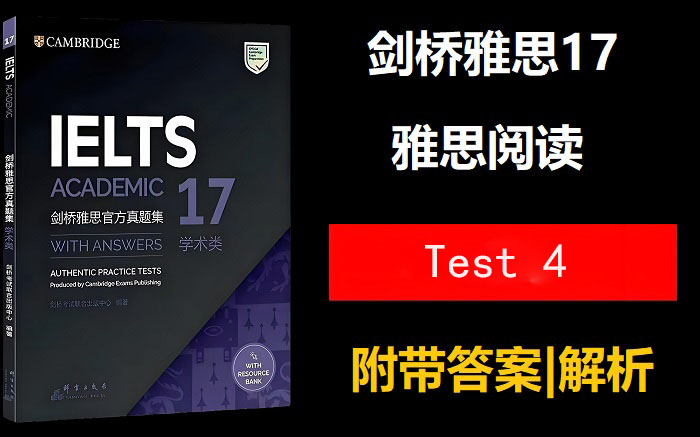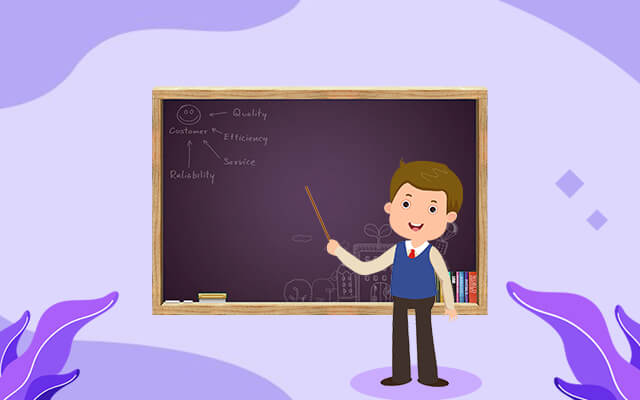剑雅17阅读真题Test4 Passage2原文
剑桥17一共收集了雅思真题4套,下文羊驼小编整理了剑雅17第四套阅读真题原文Test 4 Reading Passage 2,以下是阅读部分第二篇文章Passage 2的文章原文及参考译文,供各位烤鸭们复习参考。想要了解更多关于剑雅17听力和阅读真题答案及解析的考生可查看剑雅17听力阅读真题答案及解析汇总,为助力各位烤鸭们备考雅思,羊驼教育雅思APP推出剑桥雅思真题及答案解析视频,可在羊驼雅思APP课程一栏获取剑桥雅思系列的视频信息。

READING PASSAGE 2
You should spend about 20 minutes on Questions 14–26, which are based on Reading Passage 2 below.
Does education fuel economic growth?
A Over the last decade, a huge database about the lives of southwest German villagers between 1600 and 1900 has been compiled by a team led by Professor Sheilagh Ogilvie at Cambridge University’s Faculty of Economics. It includes court records, guild ledgers,parish registers, village censuses, tax lists and – the mostrecent addition – 9,000 handwritten inventories listing over a million personal possessions belonging to ordinary women and men across three centuries. Ogilvie, who discovered the inventories in the archives of two
German communities 30 years ago, believes they may hold the answer to a conundrum that has long puzzled economists: the lack of evidence for a causal link between education and a country’s economic growth.
B As Ogilvie explains, ‘Education helps us to work more productively, invent better technology, and earn more … surely it must be critical for economic growth? But, if you look back through history, there’s no evidence that having a high literacy rate made a country industrialise earlier.’ Between 1600 and 1900, England had only mediocre literacy rates by European standards, yet its economy grew fast and it was the first country to
industrialise. During this period, Germany and Scandinavia had excellent literacy rates, but their economies grew slowly and they industrialised late. ‘Modern cross-country analyses have also struggled to find evidence that education causes economic growth, even though there is plenty of evidence that growth increases education,’ she adds.
C In the handwritten inventories that Ogilvie is analysing are the belongings of women and men at marriage, remarriage and death. From badger skins to Bibles, sewing machines to scarlet bodices – the villagers’ entire worldly goods are included. Inventories of agricultural equipment and craft tools reveal economic activities; ownership of books and education-related objects like pens and slates suggestshow people learned. In addition, the tax lists included in the database record the value of farms, workshops, assets and debts; signatures and people’s estimates of their age indicate literacy and numeracy levels; and court records reveal obstacles (such as the activities of the guilds*) that stifled industry.Previous studies usually had just one way of linking education with economic growth – the presence of schools and printing presses, perhaps, or school enrolment, or the ability to sign names. According to Ogilvie, the database provides multiple indicators for the same individuals, making it possible to analyse links between literacy, numeracy, wealth, and industriousness, for individual women and men over the long term.
D Ogilvie and her team have been building the vast database of material possessions on top of their full demographic reconstruction of the people who lived in these two German communities. ‘We can follow the same people – and their descendants – across 300 years of educational and economic change,’ she says. Individual lives have unfolded before their eyes. Stories like that of the 24-year-oldsAna Regina and Magdalena Riethmüllerin, who were chastised in 1707 for reading books in church instead of listening to the sermon. ‘This tells us they were continuing to develop their reading skills at least a decade after leaving school,’ explains Ogilvie. The database also reveals the case of Juliana Schweickherdt, a 50-year-old spinster living in the small Black Forest community of Wildberg, who was reprimanded in 1752 by the local weavers’ guild for ‘weaving cloth and combing wool,counter to the guild ordinance’. When Juliana continued taking jobs reserved for male guild members, she was summoned before the guild court and told to pay a fine equivalent to one third of a servant’s annual wage. It was a small act of defiance by today’s standards, but it reflects a time when laws in Germany and elsewhere regulated people’s access to labour markets. The dominance of guilds not only prevented people from using their skills, but also held back even the simplest industrial innovation.
E The data-gathering phase of the project has been completed and now, according to Ogilvie, it is time ‘to ask the big questions’ . One way to look at whether education causes economic growth is to ‘hold wealth constant’. This involves following the lives of different people with the same level of wealth over a period of time. If wealth is constant, it is possible to discover whether education was, for example, linked to the cultivation of new crops, or to the adoption of industrial innovations like sewing machines. The team will also ask what aspect of education helped people engage more with productive and innovative activities. Was it, for instance, literacy, numeracy, book ownership, years of schooling? Was there a threshold level – a tipping point – that needed to be reached to affect economic performance?
F Ogilvie hopes to start finding answers to these questions over the next few years. One thing is already clear, she says: the relationship between education and economic growth is far from straightforward. ‘German-speaking central Europe is an excellent laboratory for testing theories of economic growth,’ she explains. Between 1600 and 1900, literacy rates and book ownership were high and yet the region remained poor. It was also the case that local guilds and merchant associations were extremely powerful and legislated against anything that undermined their monopolies. In villages throughout the region, guilds blocked labour migration and resisted changes that might reduce their influence.
‘Early findings suggest that the potential benefits of education for the economy can beheld back by other barriers, and this has implications for today,’ says Ogilvie. ‘Huge amounts are spent improving education in developing countries, but this spending can fail to deliver economic growth if restrictions block people – especially women and the poor – from using their education in economically productive ways. If economic institutions are poorly set up, for instance, education can’t lead to growth.’

剑雅17参考译文
教育能促进经济增长吗?
A 在过去的十年里,剑桥大学经济学院的 Sheilagh Ogilvie教授领导的一个团队 整理了一个1600年至1900年间德国西南部村民生活的巨大数据库。它包括法庭 记录、公会账簿、教区登记册、村庄人口普查、税收清单以及最近增加的9000 份手写清单,列出了三个世纪以来属于普通妇女和男子的100多万件个人财产。 Ogilvie30年前在两个德国社区的档案中发现了这些清单,他认为这些清单可能 会解答长期以来困惑经济学家的一个难题:缺乏证据表明教育与国家经济增长之 间存在因果关系。
B 正 如Ogilvie 所解释的,'教育帮助我们提高工作效率,发明更好的技术,赚更多的钱...它肯定对经济增长至关重要?但是,如果你回顾一下历史,没有证据 表明,高识字率会使一个国家更早地实现工业化。’在1600年至1900年间,按 照欧洲的标准,英国的识字率一般,但其经济增长迅速,是第一个实现工业化的 国家。在此时期,德国和斯堪的纳维亚的识字率很高,但其经济增长缓慢,工业 化也较晚。‘现代跨国分析也难以找到教育促进经济增长的证据,尽管有大量证 据表明经济增长促进了教育发展,"她补充说。
C 在 Ogilvie分析的手写清单中,有结婚、再婚和死亡时的男女财物。从獾皮到 《圣经》,从缝纫机到猩红紧身胸衣——村民们的全部世俗物品都包括在内。农 业设备和工艺工具的清单揭示了经济活动;书籍和教育相关物品(如笔和石板) 的所有权表明人们如何学习。此外,数据库中的税单记录了农场、作坊、资产和 债务的价值;签名和人们对自己年龄的估计表明了读写和算术水平;法庭记录揭 示了阻碍工业的障碍(如行会的活动)。以前的研究通常只有一种方式将教育与经济增长联系起来 —学校和印刷厂的 存在,或者是入学率,或者是签名的能力。据Ogilvie说,该数据库为同一人提 供了多个指标,从而有可能分析每个女性和男性在长期内的识字、算术、财富和 勤奋之间的联系。
D Ogilvie和她的团队一直对生活在这两个德国社区的人们进行全面的人口结构 重建,并在此基础上建立庞大的物质财富数据库。她说:"我们可以在300年的 教育和经济变革中追踪同一群人及他们的后代。”个人的生活已经在他们眼前展 开。像24岁的Ana Regina和 Magdalena Riethmüillerin的故事,他们在1707年因 在教堂读书而不是听布道而受到责罚。“这告诉我们,他们在离开学校至少十年 后仍在继续发展他们的阅读技能,"Ogilvie 解释说。该数据库还揭示了 Juliana Schweickherdt的案例,她是一名50岁的独身主义者,住在Wildberg 的黑森林小 区,1752年因"织布和梳理羊毛违反公会条例"而受到当地织工公会的谴责。当 Juliana继续从事专属于男性工会成员的工作时,她被传唤到工会法庭,并被告 知要支付相当于一个仆人年薪三分之一的罚款。以今天的标准来看,这只是一个 小小的反抗行为,但它反映了德国和其他地方的法律对人们进入劳动力市场进行 监管的时代。公会的统治不仅阻止了人们使用他们的技艺,而且还阻碍了甚至最 简单的工业创新。
E 据 Ogilvie称,项目的数据收集阶段已经完成,现在是"提出重大问题"的时 候了。研究教育是否促进经济增长的一种方法是"保持财富不变"。这涉及到跟 踪具有相同财富水平的不同人在一段时期内的生活。如果财富不变,就有可能发 现教育是否与种植新作物有关,或者与采用缝纫机等工业创新有关。研究小组还 将询问教育的哪一方面有助于人们更多地参与生产和创新活动。例如,是读写能 力、算术、书籍所有权、受教育年限吗?是否有一个需要达到的阈值水平— 一 个转折点——才能影响经济表现?
F Ogilvie希望在未来几年内开始寻找这些问题的答案。她说,有一点已经很清楚 了:教育和经济增长之间的关系远不是那么简单的。"讲德语的中欧地区是检验 经济增长理论的绝佳实验室,”她解释道。1600年至1900年间,识字率和书
籍拥有率都很高,但该地区仍然很穷。 地方行会和商会也非常强大,立法禁止 任何破坏其垄断的行为。 在整个地区的村庄里,行会阻止劳动力迁移,抵制可 能降低其影响力的变化。
‘早期的研究结果表明,教育对经济的潜在好处可能受到其他障碍的阻碍,这对 今天有影响,’奥 Ogilvie 说。‘发展中国家投入大量的资金来改善教育,但如果 各种限制阻碍了人们--尤其是妇女和穷人--以具有经济效益的方式使用他们的教 育,这种支出可能无法带来经济增长。例如,如果经济体制建立得不完善,教育 就不能带来经济的增长。’




